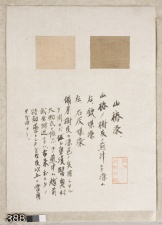Difference between revisions of "Yamatsubaki (Japanese Camellia) - left (388 L)"
Jump to navigation
Jump to search
(username removed) |
(username removed) |
||
| Line 5: | Line 5: | ||
| 388 | | 388 | ||
|- | |- | ||
| − | ! scope="row"| | + | ! scope="row"|Uemura number / title |
| − | | | + | | ; "Haze-some 25" |
|- | |- | ||
! scope="row"|Folder location | ! scope="row"|Folder location | ||
| Line 44: | Line 44: | ||
| - | | - | ||
|- | |- | ||
| − | ! scope="row"| | + | ! scope="row"|Uemura's notes |
| − | | The actual use of the plant for dyeing is unknown. According to Mr. Daisuke Okumura ( | + | | The actual use of the plant for dyeing is unknown. According to Mr. Daisuke Okumura (), the extract had been used as a medicine more than that of Kina bark in Echizen Takefu () region, Japan since ancient time. |
|- | |- | ||
| − | ! scope="row"| | + | ! scope="row"|Uemura's date |
| Kyoto | | Kyoto | ||
|} | |} | ||
| − | [[Category: | + | [[Category:Uemura dye archive]] |
Revision as of 07:21, 24 July 2013
| Museum number | 388 |
|---|---|
| Uemura number / title | ; "Haze-some 25" |
| Folder location | 5th shelf |
| Sample location | left (388 L) |
| Fiber type | silk |
| Color | pale orangish pink |
| Dyestuff (Japanese common name) | 山椿 : Yamatsubaki |
| Dye (English common name) | Japanese camellia |
| Dyestuff (botanical name) | Camellia japonica L. |
| Plant part | bark / unspecified |
| Dyestuff extraction | boiled in water |
| Auxiliary agent in dye bath | - |
| Mordant | lime |
| Other auxiliary agent | - |
| Uemura's notes | The actual use of the plant for dyeing is unknown. According to Mr. Daisuke Okumura (), the extract had been used as a medicine more than that of Kina bark in Echizen Takefu () region, Japan since ancient time. |
| Uemura's date | Kyoto |
